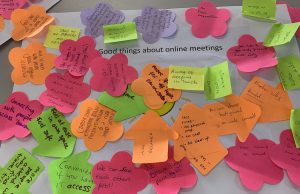Involving patients and the public in health research can improve how research is done, enable research that might otherwise have been impossible, and challenge assumptions about which research questions are being asked, and why. Patients, service users, carers and family members help ground research in lived experience and ensure that the knowledge, hopes, and values of diverse groups are central to the planning, conduct, and communication of research.
Encouraging more Public and Patient Involvement (PPI) in research is a key objective for the UK’s National Institute for Health and Social Care Research (NIHR) and may be a requirement for research funding or publication. But how common is it?

A team of our researchers – including Iain Lang, Dr Kristin Liabo, Kate Boddy and Georgia Jenkins, and PPI collaborator Angela King – looked at the frequency of inclusion and reporting of PPI in peer-reviewed health research papers. Their findings have been published in the journal BMJ Open and the paper, How common is patient and public involvement (PPI)? Cross-sectional analysis of frequency of PPI reporting in health research papers and associations with methods, funding sources and other factors, was selected as an ‘Editor’s Pick’ as one of BMJ Open’s most impactful papers of 2022.
 BMJ Open requires all the papers it publishes to include a statement about Patient and Public Involvement, even when no PPI took place. The team examined the PPI statements for every paper published in BMJ Open in 2020 (3000 papers in total) and looked at the frequency of PPI inclusion across geographical location, study method, topic, and funder.
BMJ Open requires all the papers it publishes to include a statement about Patient and Public Involvement, even when no PPI took place. The team examined the PPI statements for every paper published in BMJ Open in 2020 (3000 papers in total) and looked at the frequency of PPI inclusion across geographical location, study method, topic, and funder.
Overall, around one in five papers in the sample (20.6%) reported including PPI. The team found that research done in the UK had the highest levels of PPI inclusion. Levels of PPI inclusion also varied widely across other categories: for example, 44.5% of all UK papers included PPI compared to just 3.4% of papers from China. Mixed-methods studies and mental health research had the highest percentage of PPI inclusion. Of all the major funders who supported papers included in the study, papers that received funding from the NIHR had the highest levels of PPI.
Angela King, PPI collaborator on the team, said:
“There are two issues that stand out most strikingly for me related to PPI in the UK. The first is, despite widespread policy, the scale of disjoint between the extent of PPI in research that is frequently talked about and the extent to which it actually takes place. It begs the question what needs to happen so that PPI becomes part of how we do things around here? The second issue is that of the language authors used when writing about PPI, which wasn’t always the language of partnership or equality. PPI was often described as something that we did, we included, we decided etc. In my experience, PPI implies the presence of patients and members of the public; it isn’t something that researchers can do. This also raises another important question; who decides whether and to what extent PPI takes place?
I hope this study will inspire further investigation and better means through which to integrate all of us whose knowledge is needed to create the best possible evidence base for care.”
Iain Lang, one of the researchers on the team, said:
“If you want to change something for the better then you always need a good understanding of what the situation is that you are trying to change. Our aim in this paper was to find out how often PPIE forms part of health research studies, and how much this varies in different places and for different types of research. Now that we have this information, we can look at how PPIE changes over time and plan how to increase, broaden, and strengthen involvement and engagement.”
Jeremy Taylor, Director for Public Voice at the NIHR said:
“The NIHR is committed to ensuring meaningful public involvement in research. While this study shows that NIHR funded research studies were more likely to include PPI than studies supported by other funders, it also showed a significant minority do not. No funder can be complacent in the light of such evidence. We all need a better understanding of how and why such gaps arise and what can be done to fill them.”
*
Visit our patient and public involvement pages to learn more about our work
Related publications
